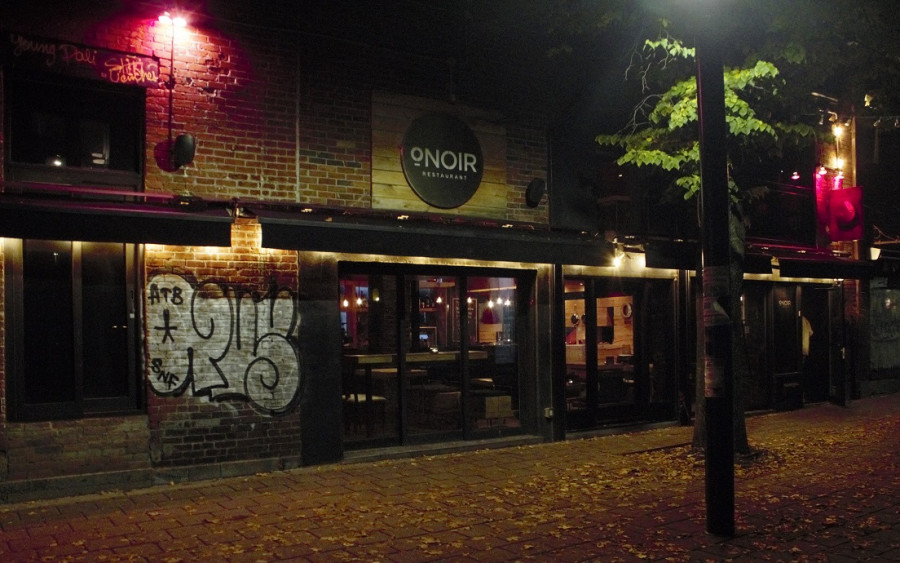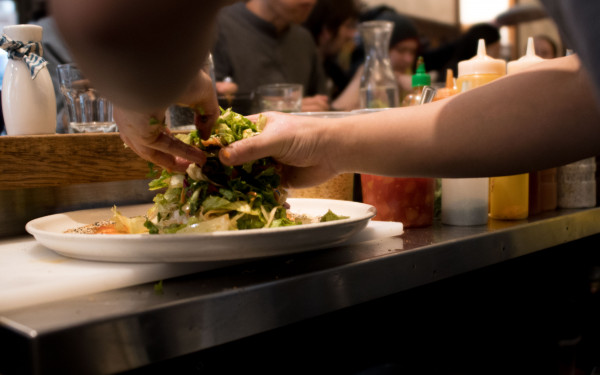The Flavours of Darkness
Experiencing Food in a New Light at Onoir
After placing my order, the head waiter led the way to table 41.
It only took a couple of seconds for me to start daydreaming as I stared into nothingness, listening to the general chatter in the dining room. When the starter finally arrived, I slowly touched the rims of my plate before picking up my fork. I could feel the weight of the food on my fingertips as I brought the fork to my mouth. Contrasting flavours and textures tingled my taste buds. A crispy and sweet dough encased a soft cheesy center.
“How is everything over here?” asked the waiter.
“Great, but I have no idea what I’m eating, to be honest,” I said, laughing.
My plate was right in front of me, yet I had no idea what it was. I could look more closely, but what was the point? I couldn’t see my plate. In fact, I couldn’t see anything. Complete darkness surrounded me.
Blind employees are the “eyes” of curious customers at the restaurant Onoir in Montreal.
This socially-conscious concept offers a unique culinary experience that invites people to enjoy their food in a pitch-black dining room. Inspired by the original concept in Zurich, Switzerland, this restaurant, founded in 2006 by Moe Alameddine, was previously located on Ste. Catherine St.
Since, Onoir has upgraded to a spacious two-storey establishment with two darkrooms, serving close to 90 guests at a time.
It was a sunny day in mid-July when I first discovered it. Taking up the corner of Prince Arthur St. and de Bullion St., this red-brick building, with black accents and a large artwork portraying a young Salvador Dali, drew the attention of numerous passersby.
Inside, an arrangement of wood-topped tables with metallic centrepieces, black napkins, and flameless candles filled up the welcome area in an elegant and minimalist fashion.
“There were many challenges to overcome,” said Alejandro Martinez, co-owner and general manager of Onoir, reminiscing about his beginnings taking over the project. “One of them was shifting the focus from the unique dark dining experience to the food.” He explained that to survive in this very competitive industry, they quickly had to consider putting more emphasis on the menu while maintaining the art of dark dining as an added value to the brand.
From 2 to 5 p.m., staff slowly rolled in as chefs started prepping for the evening service. Using seasonal produce, the menu borrowed from diverse cultures, offering striking flavours, smells, and textures that stimulated the senses.
From smoked tofu with coconut curry to a braised lamb shank with gremolata, there was still space left for the most popular item on the menu, the surprise dish. “Fifty to 70 per cent of customers want to fully experience the darkrooms,” said Mehdi Benouzekri, their chef. “They order a surprise starter, main dish, and dessert. They have no idea what they are eating, and they get the whole experience.”
Inside the darkroom, nervous laughs and good humour were contagious. Euphoria was in the air. “Ah,” “Oh my,” and “Oops!” were just some of the interjections you could hear at all four corners of the room. Dinner became a guessing game. “Is this roast beef?’’ “This must be chicken, right?”
Still puzzled by my surprise starter, the waiter arrived with the main dish of my two-course meal. A strong aroma of spices filled the air. The fish was completely boneless, with the thin crispy skin still on top of the flaky flesh. Using my fingers this time, I started exploring my plate.
Right behind me, I could hear Sami Mian, one of the guide waiters, ask a customer if he needed anything. “Maybe a little light?” the customer joked.
I later found out that, despite the laid-back atmosphere, dark dining is not all fun and games. Among a total of 28 employees, 11 visually-impaired staff members manage the darkrooms. Training of the staff can take anywhere from one to two months to ensure that they develop sufficient abilities to successfully navigate the invisible maze.
“When I first started working here, I would always be mentally exhausted at the end of the day,” Sami told me. “But with time, it slowly got better. A new waiter will most definitely go through the same struggles.”
I later learned that he was not born blind. In fact, his vision loss is somewhat recent. He explained that, although he is used to it now, it took a great deal of perseverance and focus to properly hone his other senses, which now guide him.
I could tell that, for Sami, building trust with the guests was the most important part of his work. After escorting them to their seats in the pitch-black room, he would often check up on them to make sure that everything was okay and answer any questions they might have.
“The customers are very brave to come and try such an experience,” he said. “They are always so happy to tell us about it. They appreciate what we do, and we appreciate the way they think and their reaction to us.”
“In the darkrooms, it’s not the waiters who have a disability, […] it’s the other way around,” Martinez told me. “For our darkrooms, waiters must be visually-impaired. We keep those jobs for them.”
Compassion, empathy, and open-mindedness are the main themes of this inclusive project. The concept contributes to breaking stereotypes and creating trust between complete strangers. Strong communication remains the backbone of the entire operation.
After being blinded by the light for a couple of seconds, my first steps out of the darkroom, where I had stayed for over an hour, were filled with meditative thoughts and a slight sense of confusion.
At the bar, Laurence Carrière, the barmaid, carefully handed six drinks to Sami, naming them one by one as he methodically placed the cold beverages onto his tray. As I walked out, I remembered being told that some people cry when leaving the darkroom, feeling privileged for having the luxury of sight.
“Darkness has never been so enlightening,” I thought to myself.
A previous version of this article stated the name of one of the waiters as “Sammy Mian.” In fact, the waiter’s name is Sami Mian. The Link regrets this error.




_600_375_90_s_c1.jpg)
41_600_375_90_s_c1.jpg)
